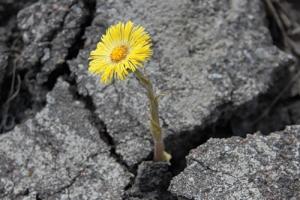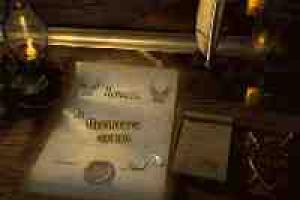Autumn leaves are an original and accessible material for creativity, including for working with children. You can use them to make not only traditional panels and appliqués, but also three-dimensional crafts. A bouquet of flowers made from bright and fresh foliage looks very stylish and original. Let's take a step-by-step look at how a rose can be made from the most ordinary maple leaves quickly and easily with your own hands, and let's try to make an unusual bouquet.
How to make a rose from maple leaves with your own hands in MK
Required materials and equipment:- fresh maple leaves and leaves of other trees;
- rowan branches, maple fruits, dried flowers;
- reinforced threads or thin wire of brown or green color;
- scissors;
- wooden twigs;
- aerosol paint (if desired);
- fixative varnish;
- paper, ribbons or other decor for bouquet decoration.
Leaves should be chosen that are clean, bright, and without mechanical damage. You can choose foliage of the same color or choose multi-colored natural materials. If necessary, they should be washed and dried thoroughly before use, dry areas and inhomogeneities should be removed. You can pre-treat the leaves with glycerin to add shine, elasticity and durability. In addition, glycerin will help preserve the color of the bouquet if dyeing is not used.
Operating procedure.This master class is suitable for beginner needlewomen and children. We select a small leaf and carefully roll it into a tube with the front side out to form the center of the future rose. Fold the next slightly larger piece of paper in half and wrap it tightly around the first piece. We try not to break the leaf, but to make the bend as round as possible. For this reason, you should not use dried natural materials.

We do the same with other maple leaves. Each next leaf should be slightly larger than the previous one. We make sure that the glossy and bright front side of the sheet is always on the outside. To enhance the decorative effect, the leaves can be slightly twisted, forming beautiful folds and flounces. Some leaves don't need to be bent, allowing the sharp edges to stick out. Such flowers look more natural and natural. If necessary, carefully cut off excess parts of the leaves with scissors.
Having made the rosette of the required size, we secure it with threads, wrapping them several times around the bottom of the bud. Large flowers can be fastened with threads several times for reliability. To make a rose with a long stem, we fix it on a twig. This can be done at the initial stage of making the flower, or you can discreetly attach a ready-made rose to the stem.
To make a bud, you need to roll the leaves as tightly as possible to each other and form the blank as round as possible. Some of the outer leaves can be slightly bent outward, being careful not to damage the workpiece. The middle should not stand out too much above the other layers of the rose; it is better if it is slightly recessed into the bud.

The thicker and larger the bud, the more difficult it is to wrap around it and secure the leaves. For additional fixation, you can use a stationery stapler. To do this, you need to carefully secure several leaves with a bracket in the middle of the bud, trying to place it closer to the upper edge of the flower, but so that the bracket is not visible. Additionally, we secure the buds with reinforced threads, wrapping the blanks as tightly as possible in the lower part and along the entire length of the branches.

Roses and buds can be made in different shapes and sizes, wrapping the leaves tightly or more loosely. Having made several flowers and buds, we collect them into a bouquet. Between the roses we place leaves of various trees, dried flowers, maple fruits or other natural materials. If the stems of the roses are expected to be visible, they can be wrapped with ribbon, string, or green elastic tape.
To ensure that the bouquet does not darken over time and retains its bright, rich color, it should be treated with 1-2 layers of fixative varnish and allowed to dry. You can use parquet or construction varnish. Hairspray with glitter will give an unusual effect. Flowers and leaves can be painted using spray paints if desired. It is advisable to make several layers of paint with intermediate drying. Cracks and folds in the leaves can be left unpainted or carefully painted over with a thin brush.
Cut a piece of wrapping paper or decorative mesh for flowers and wrap it around the bouquet, forming beautiful folds and flounces. We secure the bouquet with a ribbon or thread and place it in a vase without water.

An unusual bouquet of roses is ready! You can give it as a gift or surprise guests by decorating their room. In order for maple roses to please you as long as possible, you should not expose them to bright sunlight or mechanical damage.
Video selection on the topic of the article
Bouquets of maple leaves will give a wonderful mood and will be an excellent reminder of outdoor recreation. To make roses and bouquets from natural materials, we suggest watching the video lessons below with a step-by-step description of the manufacturing process.
It’s very sad to watch how autumn comes after a sunny summer: the leaves on the trees turn yellow, it almost always rains, it becomes cold outside, you have to take warm things out of the closets.
Despite this, autumn can also become beautiful and full of colors during the onset of sunny days. Cheerful children run through city parks, play, and collect colorful bouquets from fallen leaves.

At home I start collecting various crafts for school and kindergarten, and sometimes just for myself. There are a huge number of exciting ideas, and our article will be about them.

Leaf crafts for kindergarten
The child loves to take part in creating various crafts. Show him what can be made from the colorful leaves that filled all the streets of your yard, and he will be incredibly happy to take part in it.
Creating crafts is not only fun; thanks to such activities, children can get wonderful, exciting lessons in getting to know the world around them, develop thinking and creativity. The presented options for working in kindergarten will help you with this.

What is needed for crafts from autumn leaves:
- The leaves themselves, of different colors, sizes and types;
- Stationery (Glue, pencil, scissors, paper, white and colored cardboard);
- Threads;
- Wish.

Possible options for crafts made from leaves
Applique of autumn leaves
It is considered the simplest type of crafts made from leaves. You and your child can easily make an applique in the form of animals or birds.
You can create a lot with dry leaves, PVA glue and paper. To make your work more vibrant, use leaves of different colors.
Crafts from leaves and cardboard
Making a craft from cardboard and leaves is not difficult. You just need to cut out the base from cardboard and glue dry leaves to it.
Herbarium
One of the most exciting and common types of crafts for children is an amateur herbarium. You can collect many types of natural material, which will help your child to study with interest the variety of plants growing in your area. Include as many plant species as possible to create a beautiful herbarium.
Garland of autumn leaves
Dry the leaves, then dip each of them in yellow paint to give the leaves a brighter color. Then we hang the leaves to dry in the form of an elegant garland.
You need to take maple leaves of different sizes and colors, then cover them with transparent varnish. After the leaves have dried well, you need to hang them on strings, decorate them with beads or beads and hang them. The resulting pendant will be an excellent decoration both outdoors and indoors.

Bouquet of flowers from autumn leaves
Flowers created from maple leaves look very impressive.
Vase of leaves
You can use any leaves you like. For one vase you can use several types of leaves, different in color and shape, or you can make them from the same ones.

Instructions on how to make crafts from leaves Applique First, you should prepare all the necessary materials and cover the table with oilcloth.

To create an overlay applique, you should draw the picture itself on cardboard, then put leaves on the drawing, there is no need to cut the leaves, they are used entirely. Anything that is not enough can be painted on with paints or made from other materials.

Silhouette applique is created from cut leaves. The leaves are cut to realize the intended design with their help.

The most difficult way is to create a modular application. It is made from leaves of the same size. Fish scales or bird feathers are made in this way.

To obtain a symmetrical application, it is necessary to select paired leaves that are identical in all respects.
Note!


Tape - with its help, many details are created in one drawing.
Herbarium
It is better to collect leaves for the herbarium in dry weather, since wet leaves require additional processing. Each part of the herbarium must be straightened with a cold iron; before this, all creases in the sheet must be carefully removed.

If there is constant dampness outside and there is no time to wait for dry weather, then they should be given the opportunity to dry on their own. After the leaves have dried, they are ironed with a warm iron, placing them between two sheets of paper. There is no need to press the leaves with an iron, just press a little so as not to flatten them.
The prepared elements are placed on a sheet of paper, which will serve as a background and at the same time a frame. Fix the leaves with threads or glue.
Bouquet of flowers/rose
In order to get neat and beautiful flowers, the leaves must be even and clean. Place the piece of paper directly in front of you and fold it in half. Then you need to twist half the leaf into a tube, but do not twist it very tightly, the flower should be voluminous.

The result is the core of the flower; we make the petals from the remaining leaves. The core is placed in the second maple leaf. Take turns folding the edges of the sheet to form petals. The sheet can be secured with thread so that it does not fall apart later.

Note!

To make the flower voluminous, you should twist at least six or seven maple leaves in this way, each of which is secured with a thread. To create a bouquet you need several of these flowers.
Vase
To make this craft you will need:
- PVA glue;
- Leaves of different colors;
- An ordinary balloon.

You need to inflate the balloon to the desired size of the vase. Take glue diluted half and half with water. Lubricate one half of the ball with adhesive solution.

Each sheet must be properly glued and lubricated with another layer of solution on top so that the upper layers of the sheets adhere just as well. When you have glued the top layer, it should also be lubricated with glue.

After this, remove the ball for several days until it hardens completely. When our fake is completely dry, you will need to burst the balloon. A vase of leaves is suitable for use. Making such work is not difficult, but it is very interesting, so it is good to do it with children.
Photos of crafts made from leaves

Note!







Autumn is often associated with yellowing leaves on trees. They are not only beautiful in themselves, but can also serve as a natural material for creating chic bouquets. If you don’t yet know how to turn an ordinary leaf into an incredible flower, then we suggest you read our publication.


What leaves are roses made from?
Unfortunately, any leaves are not suitable for creating exclusive roses. You need to choose wide leaves that will not tear at the first touch, but also that they are not too hard.
The following foliage is ideal for this craft:
- maple;
- linden;
- viburnum;
- oak;
- poplar;
- rowan;
- elm
When collecting leaves for crafts, it is important to think through the color scheme in advance and select foliage according to tone.
How to make a rose from leaves with your own hands
The main thing in this craft is the leaves themselves. Collect specimens that are not torn, not overdried, and aesthetically beautiful. Before you start creating a flower, wash the leaves thoroughly and lay them on a towel to dry. Don’t dry it, just let it dry a little and you’re good to go. In addition to the foliage, you will need thin wire and a small stick to make it easier to create the center.

The rose is ready. By making several of these roses you can form a bouquet or other composition.

Rose from maple leaves master class
The maple leaf is ideal for creating a rose due to its size and color palette.
Sort the washed maple leaves by size and color.
Important! Leaves must have petioles!
Take one sheet and fold it in half, right side out.

Roll it into a tight tube.

Take the second sheet with the front side facing you, bend the top back so that it folds in half. Next, attach this sheet to the roll from the previous step, so that it is in the middle of the sheet, and wrap the sides protruding from it 2 times. Pinch the leaf at the base so that the bud does not fall apart.

Attach each subsequent leaf to the bud in the same way, placing it on the opposite side of the core. The more leaves, the more magnificent your rose will be.

After the rose is finally formed, secure its base with several skeins of thread or thin wire.

How to make a rose from a maple leaf step by step
There are several options for how to make a rose from maple leaves, and our next master class shows how you can form a flower using the structure of the leaf itself. Stages:

The rose is ready.

TIP: To keep your roses from drying out for as long as possible and their appearance from deteriorating, lubricate the finished products with sunflower oil or spray them generously with hairspray. You can also pre-soak the leaves in a solution of water and glycerin (2:1).
Rose from a maple leaf video
Bouquet of roses from leaves, photo



Autumn is a golden time. Fallen leaves cover the ground with a magic carpet. Who among us has not brought leaves home? However, although they are unusual in color, it will be much more interesting to create an autumn bouquet of leaves and decorate your home with them.
We offer a master class describing several options for creating such a product with your own hands. It will not only add zest to your home, but also to your autumn photo shoot.
Memories of autumn
We will need maple leaves of various colors and thread.
Fold the first sheet in half crosswise. And roll it into a tight tube.



This will be the middle of our flower. Now take the second sheet and apply the front side to the bud blank. We also fold it in half, maybe 1/3.

Then slightly turn away the top of the second petal and wrap it around the bud. On the contrary, we attach the third sheet in the same way.
This is how we form the entire flower, and each subsequent row should fit a little looser to the previous one.


We fasten the thread at the base.
For your confidence, if you are making such a bouquet for the first time, you can attach each leaf to the sewing.

We wrap the bouquet with a larger leaf than was used for the flowers, and also secure it with thread.


You can wrap it in beautiful paper, or you can leave it like that.

Another variant

This option also consists of roses, but the folding of the leaves is different.
Here's what we need:
- 10 maple leaves of different sizes and colors per flower. They should be slightly dry, even freshly fallen, as they will be more plastic;
- right there in the forest you can pick up twigs, they will go into stems;
- green tape;
- scissors.

We take the smallest leaf and turn it with the inside facing us. Folding the tops, wrap them into a roll. We get the middle of the flower, as shown in the photo.

We take the second leaf, bend the middle top and apply it to the bud. Then, bending the edges of the sheet one by one, we wrap it.


This way we attach the leaves. It is better to apply them in order of increasing size and overlap.

We can secure the finished flower with thread. We attach a twig to it, wrap it with tape from the base of the flower and along the entire length of the stem.

We combine all the resulting flowers into a bouquet. We can decorate at our discretion.

Adding variety

We will need:
- slightly dry leaves of birch, aspen, etc.;
- jute rope;
- balloon;
- PVA glue;
- glue gun;
- branches with rowan berries.

As you can see, you need to make a ball out of jute thread. We take a balloon, inflate it and wrap it in jute, while generously greasing it with PVA glue (you can also use wallpaper). We are waiting for it to dry. We pierce and remove the ball.
Now let's start making flowers. To do this, take a piece of paper and roll it into a little bag, fastening the edges with hot glue.

We wrap the next sheet around it and also use glue. In this way we attach all the leaves, and each subsequent one should be equal to or slightly larger than the previous one. Forming a rose bud.




You can apply hot glue to the petals to imitate dew. Now we insert the flower into the jute ball and secure it with glue.

This is how we design the entire ball.
If desired, at the stage while the jute ball is still wet, you can make a flat bottom and decorate only the convex part.

Now we fill the voids with rowan berries so that the jute is not visible at all.

Such a non-standard bouquet can fit on a vase, or you can provide a loop and then hang it, for example, on a door.

Fourth method
It is most likely suitable for joint creativity with a child, because it is very simple and does not require special skills.

Material and tools:
- leaves (children will have fun collecting them with you);
- thin branches for the stem;
- cardboard;
- PVA glue;
- green paint, preferably acrylic, but gouache and watercolor are also suitable;
- brush;
- half-liter glass jar;
- piece of fabric;
- rubber;
- satin ribbon.

We glue the leaves onto a piece of cardboard in a circle, overlapping them, and choose the largest ones.

We take a little smaller leaves for the next row and place them in a checkerboard pattern relative to the previous ones.

The third, and for our example the last, row can be made of three small leaves, or we can take petals of dried flowers.

We can cover the middle with a bead or rhinestone, or we can glue a very small sheet and paint it. A piece of fabric is used here.

While our flowers are drying (choose the quantity yourself), we paint the branches green.

When all the parts are dry, attach the flowers and individual leaves to the branch.

Now let's take care of the jar. We decorate it with fabric, securing it at the neck with an elastic band, and covering the fastening with a satin ribbon.


We place our flowers in a transformed jar. Although, if desired, it can be replaced with a beautiful vase.

As you can see, there is a ton of potential in fall foliage. You can create amazing bouquet arrangements by adding additional decor in the form of berries, dry herbs, pine cones, etc.
Video on the topic of the article
DIY bouquet of maple leaves: master class in step-by-step photos for children and adults. Video.

DIY maple leaf bouquet
This master class was sent to our competition of children's autumn crafts by Polina Skorikova and her mother Yulia.
I give the floor to Polina and Yulia to conduct the master class.
DIY maple leaf bouquet: materials and tools
To make the bouquet we needed:
- a large number of maple leaves (clean, not dried out, not diseased),
- basket,
- filler (straw),
— artificial snow (spray),
- stapler or thread.
— elastic band (for fastening the bouquet).
Polya, her sister Ksyusha and mother Yulia were collecting leaves near the house. Then, on the same day, we made a craft (Polina and her mother).
While collecting maple leaves for a bouquet, you can read a poem to the children:
There lived a carved maple leaf,
In the morning I listened to the bird whistle,
Rusted on a maple branch
And all summer it was green,
Liszt dreamed that he could do it himself
Soar to the blue skies.
Time passed and according to signs
Indian summer has arrived.
Our leaf has become colored -
Red-yellow – painted.
The autumn wind has arrived
I noticed him from afar,
Spun and tore off...
“I’m flying!” the leaf said.
(Irina Blazhevich)
Do-it-yourself bouquet of maple leaves: step-by-step description and step-by-step photos
Step 1. Making the core. At the very beginning, you need to make the “core” of the flower bud. To do this, fold the maple leaf in half.

Then this folded sheet must be rolled into a tube.

The core is ready.
Step 2. Making the petals.
Then you need to make the “petals” of the bud. To do this, you need to also fold the other leaves in half and attach them to the “core” as shown in the photo below.

And we wrap the petals around the “core”.

At the bottom, each petal must be fastened. You can use thread, but we used a stapler.
Step 3. We assemble a bouquet of maple leaves into a composition.
We fasten the finished bouquet at the bottom with an elastic band to hold it in place and place it in the basket.
We put stuffing on the bottom of the basket (we used straw) to make the bouquet stand more stable. We make a hole in it for the bouquet.
We spray the flower buds with artificial snow (spray) so that they turn white. A bouquet of maple leaves is ready!

Do-it-yourself bouquet of maple leaves: step-by-step video
If you prefer to make crafts using step-by-step videos, then you will find another version of the master class on making a bouquet of maple leaves with your own hands in the video below. This is a video master class from the teachers of the FLORET studio - a floristic studio from Arkhangelsk.
Bouquet of maple leaves- a wonderful gift for family and friends! Make it these autumn days with your children and enjoy the beauty of nature!








